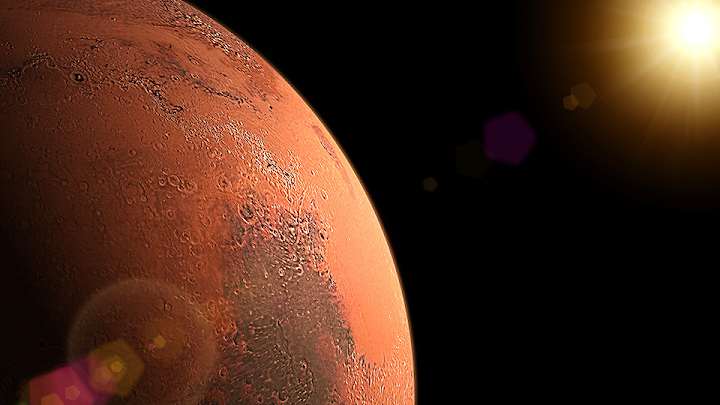How would football work if you tried to play it on Mars?

By Rhett Allain, WIRED
A human colony on Mars will need several things: air, water, protection from radiation, and football. OK, maybe the colonists wouldn’t technically need football, but they will probably want it. Mars isn't just a red desert, though. It has lower gravity and a less dense atmosphere. And both those factors would make football very, very different than the game we play on the Big Blue Marble.
Lower Gravity
The gravitational force is an interaction between objects that have mass. When you are standing on the Earth, the two objects interacting are you and Earth. You can calculate this gravitational force if you know the masses of the two objects and the distance between their centers. (Because you're are not so tall compared to the size of the planet, that distance is essentially just Earth's radius.)
If you move to the surface of Mars, those factors obviously change. Mars has a mass that is just 0.107 times Earth's and a radius of about half of Earth's. The combination of these two differences produces a gravitational field about a third of what you grew up in, presuming you grew up on Earth.

So a person who weighs 700 newtons on the surface of the Earth (about 157 pounds-force) would weigh only 265 newtons on Mars. You wouldn't just feel lighter; you'd also run differently. Think of running as a bunch of tiny jumps—since both feet are off the ground at the same time; otherwise it would be speed walking). Let’s say that a human takes a stride with an initial velocity v at an angle of θ.

Using some basic projectile motion equations, you can find the distance this object (or human) will travel over level ground before coming back to the surface.

Here s is the distance traveled and g is the gravitational field. As you can see, decreasing the gravitational field will increase the distance traveled. On Mars, with a gravitational field 1/3 the value, a runner with the same starting velocity and angle would travel 3 times as far.
Look for new entries in the Super Bowl 100 series, presented by Gatorade and Microsoft Surface, at SI.com/SB100 and Wired.com/sb100
Chapter 1, Oct. 7 TRAINING
Chapter 2, Oct. 28 EQUIPMENT
Chapter 3, Nov. 18 STADIUMS
Chapter 4, Dec. 9 CONCUSSIONS
Chapter 5, Dec. 16 MEDIA
Chapter 6, Dec. 30 VR
Chapter 7, Jan. 6 NFL IN SOCIETY
Chapter 8, Jan. 13 TRACKING
Chapter 9, Jan. 20 STRATEGY
Chapter 10, Jan. 27 SB 100
ROAD MAP TO
THE FUTURE
(On the moon, it’s even worse. With a normal motion, a human would go about 6 times as far with each stride. Here you can see that just walking at a brisk pace on the moon turns into a skipping motion.)
Note: I am making some assumptions about how a human would move in lower gravity. Of course, the assumption that the human would launch with the same velocity and same angle as on Earth probably isn't true. Still, it's a good place to start until people actually get to Mars and see how humans move there.
But what does that have to do with football? Well, of course running plays would look different, but I think that would have a large impact on gameplay. When a player takes large strides in the air, they can't turn. In a normal game on the surface of the Earth, players come in contact with the ground quite often. During these interactions, the player can push on the ground to either change his speed or direction. Off the ground, the player has no control over his motion. He or she would be like the ball once it leaves the quarterback’s hand. A player off the ground for an extended time would be vulnerable to mid-air collisions.
I wonder if this would lead to an increase in fake runs. You see this in the NBA, where players with the ball fake jumps to get the defender to jump. Defenders in the air is mostly useless; they can't change direction.
But wait, there’s more. If we assume the Mars Football League players can throw the ball just as fast as on Earth, then their range would also increase by a factor of 3. If you could throw it 50 yards on Earth, that would be about 150 yards (ignoring air resistance) on Mars. If you've read this far, I probably don't need to remind you that the distance from one end zone to the other is 100 yards.
What about jumping? If a player on Earth jumps straight up with an initial velocity v, it isn’t too difficult to calculate his maximum height during the jump. You can do this as a homework problem but the answer is:

Assuming the same jumping speed, a person on Mars could jump 3 times higher. That is a serious jump. Consider the interception possibilities.
Maybe on Mars they should just use a bigger field.
Less Dense Atmosphere
You can’t just go for a stroll on the surface of Mars—at least not without a space suit. The primary role of these suits is to put the human inside an atmosphere closer to the chemical composition and pressure of the atmosphere on the surface of the Earth. For spacesuited humans, this pressure is something greater than 0.06 that of the Earth’s atmosphere. This value is called the Armstrong limit, the pressure that water would boil at the temperature of a human body. The atmospheric pressure on the surface of Mars is just 0.006 times that on Earth. Wear a pressure suit.
But ... existing pressurized suits are difficult to move in—not just because of their bulk but because of the pressurized air inside. Let me demonstrate with a thought experiment.
Suppose you look at just the arm of an astronaut inside a pressurized space suit. Now, for some reason, the astronaut bends the arm. What happens? Take a look at this illustration (from a previous post on spacesuits).

In order to bend the arm, the total volume of gas inside the spacesuit must decrease. This takes work on the part of the human to compress this air—and it isn’t as easy as you would think.
One solution might be to create a constant-volume suit such that moving arms and legs does not change the volume of air inside. That's a hard-shell suit with rotating joints. NASA has created several versions, like this AX-5 model. None have made it to space.
The second (and probably better-looking) pressure suit design uses some type of tight material that pushes on the outside of the human body. It would be like a very tight wetsuit, but more complicated. The tight material would take the place of the higher-pressure air and keep the human happy and alive. Of course, if the suit is too tight in some spots it could cut off blood circulation. Too loose, and you get boiling blood. On top of that you would need something in place to regulate temperature and block the deadly radiation that's part of the fun on Mars. In the case of a football spacesuit, you also have to worry about collisions damaging the life support system. Getting a hole punched in your suit would result in more than just a 15-yard penalty.
Another possibly solution: What if all the football players just shared one giant pressurized suit? We could call this giant suit a “football dome.” Actually, this would make the construction of such a building a little bit easier. Instead of using mechanical structures to support the roof of the dome, it could just be “blown up” like a balloon. You'd just need to make sure it was long and tall enough to hold the players who are jumping so much higher, and taking such long strides. Now that would be a Super Bowl.

